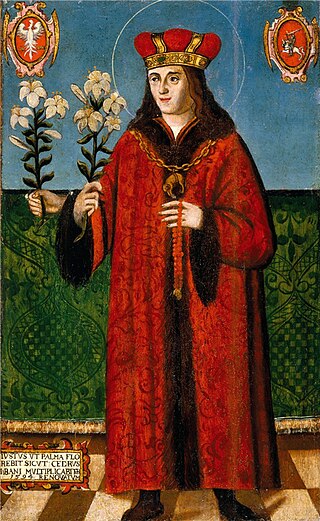
Casimir Jagiellon was a prince of the Kingdom of Poland and of the Grand Duchy of Lithuania. The second son of King Casimir IV Jagiellon, he was tutored by Johannes Longinus, a Polish chronicler and diplomat. After his elder brother Vladislaus was elected as King of Bohemia in 1471, Casimir became the heir apparent. At the age of 13, Casimir participated in the failed military campaign to install him as King of Hungary. He became known for his piety, devotion to God, and generosity towards the sick and poor. He became ill and died at the age of 25. He was buried in Vilnius Cathedral. His canonization was initiated by his brother King Sigismund I the Old in 1514 and the tradition holds that he was canonized in 1521.
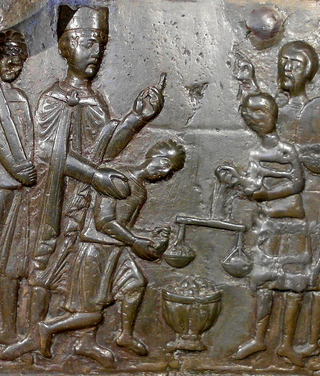
Bolesław I the Brave, less often known as Bolesław the Great, was Duke of Poland from 992 to 1025, and the first King of Poland in 1025. He was also Duke of Bohemia between 1003 and 1004 as Boleslaus IV. A member of the ancient Piast dynasty, Bolesław was a capable monarch and a strong mediator in Central European affairs. He continued to proselytise Western Christianity among his subjects and raised Poland to the rank of a kingdom, thus becoming the first Polish ruler to hold the title of rex, Latin for king.

Bretislav I, known as the "Bohemian Achilles", of the Přemyslid dynasty, was Duke of Bohemia from 1034 until his death.

Poraj is a Polish Coat of Arms. Used by several knighthood families of medieval Poland and noble families of the Polish–Lithuanian Commonwealth - those descended in the male-line from the Poraj family and those allowed into the heraldic clan by adoption.
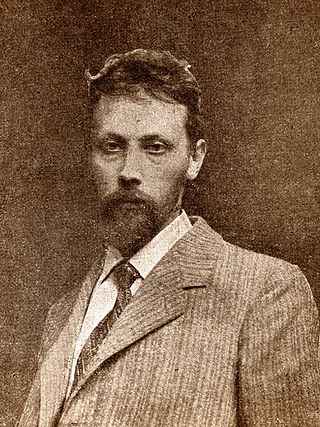
Antoni Wiwulski was a Polish-Lithuanian architect and sculptor.
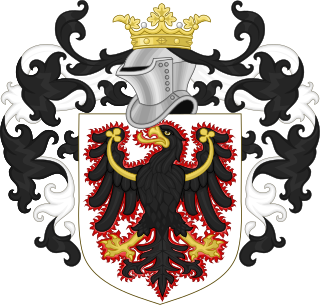
The Přemyslid dynasty or House of Přemysl was a Bohemian royal dynasty that reigned in the Duchy of Bohemia and later Kingdom of Bohemia and Margraviate of Moravia, as well as in parts of Poland, Hungary and Austria.
The Crosiers or Brethren of the Cross or crutched friars is a general name for several loosely related Catholic orders, mostly canons regular. Their names derive from their devotion to the Holy Cross. They were founded in the 12th and 13th centuries, during the era of the crusades in the Holy Land. These orders tended to maintain hospitals and care for the sick. Currently, the term "crosiers" most frequently refers to the Canons Regular of the Order of the Holy Cross originating from Belgium, but it could also refer to at least five other orders from Jerusalem, Portugal, Italy, Bohemia, Poland–Lithuania, and a group of friars in England and Ireland.

The Crosiers, formally known as the Canons Regular of the Order of the Holy Cross, abbreviated OSC, is a Catholic religious order of canons regular of Pontifical Right for men. It is one of the Church's oldest religious orders, and membership consists of priests and brothers who live together according to the Rule of St. Augustine.

Elizabeth of Pomerania was the fourth and last wife of Charles IV, Holy Roman Emperor and King of Bohemia.
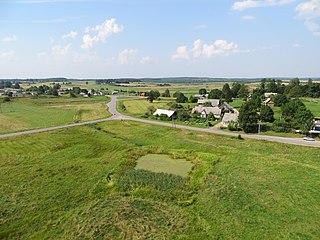
Medininkai is a village in Lithuania. Administrationwise it is centre to the Medininkai Eldership, which forms part of the Vilnius District Municipality; the district itself is in turn part of the Vilnius County. Beginnings of the village are related to the 14th century. The local castle was among the key ones in the Grand Duchy of Lithuania; in 1387, upon christening of the country, the grand duke Jogaila founded one of the first 7 churches here. Medininkai enjoyed its golden era in the late 15th century. In the early modern period the settlement reached the status of a town, but it failed to develop into a major urban centre. Over time the place was losing importance, and at the turn of the 19th and 20th centuries it was reduced to a village. The area has retained its traditionally rural character, though during recent decades it started to host transport and spedition businesses, related to the nearby Lithuania-Belarus border crossing at the Vilnius-Minsk highway. Since the early 21st century Medininkai is home to a major compound which educates border-control officials. The place enjoys some appeal among tourists; visitors are attracted by ruins of the castle, now turned into a museum, and the highest natural point in Lithuania, named Aukštojas. The village and the eldership are populated mostly by members of the Polish national minority.
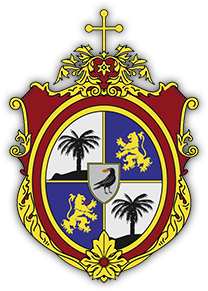
The Order of Saint Paul the First Hermit, commonly called the Pauline Fathers, is a monastic order of the Catholic Church founded in Hungary during the 13th century.
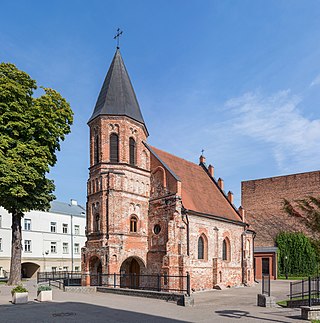
Church of St. Gertrude is located in the Old Town of Kaunas and is one of the oldest Brick Gothic churches and buildings of Gothic architecture in Lithuania. Located just off Laisvės alėja, the church is somewhat hidden away and can be accessed from Laisves aleja through a gate at a hotel which is located nearby the Court building on Laisves alėja.
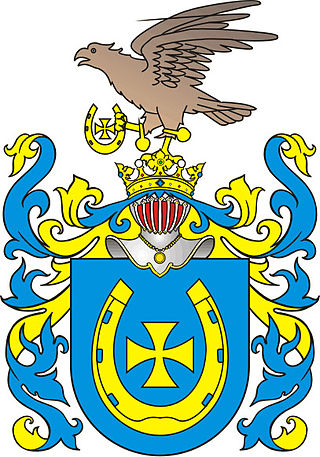
Bartosz Paprocki was a Polish and Czech writer, historiographer, translator, poet, heraldist and pioneer in Polish and Bohemian-Czech genealogy. Among his many historical works, are the famous publications "Gniazdo Cnoty, Zkąd Herby Rycerstwa slawnego Krolestwa Polskiego..." in 1578 and "Herby rycerstwa polskiego" in 1584. Paprocki was active in Poland until the turn of the sixteenth to seventeenth century when for political reasons he became an émigré in Moravia and Bohemia. He is also founder of the Polish village of Bartoszowiny in Świętokrzyskie Province.
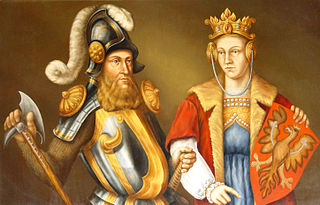
Princess Elisabeth of Poland (1326–1361) was the eldest child of Casimir III of Poland and his first wife, Aldona of Lithuania.
Casimir of Bytom was a Duke of Opole during 1282–1284 and Duke of Bytom from 1284 until his death.

The Imperial Roman Catholic Theological Academy was an institution of higher education preparing Roman Catholic theologians in the Russian Empire. The academy granted master's and doctorate degrees in theology and was designed to prepare clergy for senior positions in the Catholic Church hierarchy. It originated at the Vilnius University, but was transferred to Saint Petersburg in the aftermath of the Uprising of 1831. The Tsarist authorities wanted to exercise greater control over the academy and implement Russification policies. After the October Revolution in 1917, the academy was moved to Poland where it became the Catholic University of Lublin. A new theological seminary was established in Moscow in 1993; it moved to the premises of the historical Saint Petersburg Academy in 1995.

The Jagiellonian or Jagellonian dynasty, otherwise the Jagiellon dynasty, the House of Jagiellon, or simply the Jagiellons, was the name assumed by a cadet branch of the Lithuanian ducal dynasty of Gediminids upon reception by Jogaila, the Grand Duke of Lithuania, of baptism as Władysław in 1386, which paved the way to his ensuing marriage to the Queen Regnant Jadwiga of Poland, resulting in his ascension to the Crown of the Kingdom of Poland as Władysław II Jagiełło, and the effective promotion of his branch to a royal dynasty. The Jagiellons reigned in several European countries between the 14th and 16th centuries. Members of the dynasty were Kings of Poland (1386–1572), Grand Dukes of Lithuania, Kings of Hungary, and Kings of Bohemia and imperial electors (1471–1526).

Monastery of the Holy Trinity is a monastery built in Vilnius by the Ruthenian Church and Grand Hetman of Lithuania Konstanty Ostrogski as a thanksgiving to the God for the victory in Battle of Orsha. It now belongs to the Order of Saint Basil the Great and the Ukrainian Greek Catholic Church.

Blessed Michał Giedroyć was a Lithuanian Roman Catholic noble and brother of the Canons Regular of the Penitence of the Blessed Martyrs. Giedroyć did not have any great accomplishments, but his life followed Devotio Moderna, a movement calling for genuine pious practices such as humility, obedience, and simplicity of life.
The Polish–Bohemian War or Polish–Czech War was fought between the Kingdom of Bohemia under John of Bohemia and the Kingdom of Poland under Casimir III the Great between 1345 and 1348. After fighting in Silesia and Lesser Poland, the Bohemian army advanced on Silesia and Lesser Poland in 1345, including on the Polish capital of Kraków. An armistice signed later that year held until 1348, when hostilities resumed. Although Poland had a slight military advantage, the war ended with the Treaty of Namysłów signed in November 1348. No territorial changes were made. The Poles renounced their claims to Silesia, and the Bohemians their claims to the Polish throne.





















